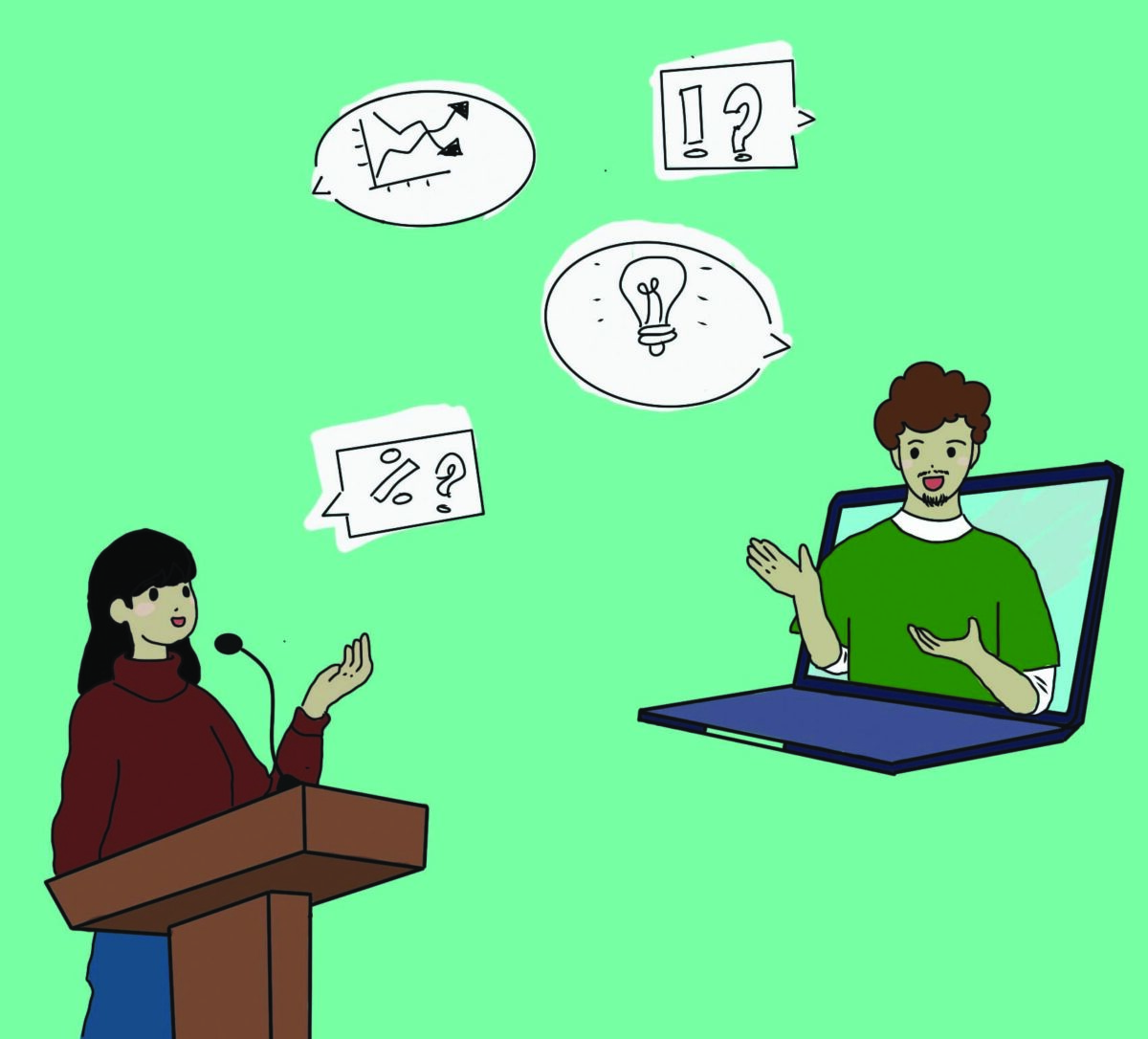Two Bulletin reporters debate the more effective learning method.
By Andrea Ambriz & Rafael Rodriguez, Staff Reporters
In an era of Zoom lectures, asynchronous assignments, and technology-driven classrooms, the debate over online versus in-person learning continues to play out across college campuses. So The Bulletin’s staff decided to weigh in on the topic with a friendly debate between the two staff reporters: junior Andrea Ambriz and senior Rafael Rodriguez.
Rodriguez prefers the flexibility and accessibility of online classes, while Ambriz prefers interacting with people face-to-face. What follows is a Socratic-style conversation, edited for clarity, between the two reporters (and journalism students) as they explore the pros and cons of online and in-person learning from their own experiences.
Rafael: To start off, online courses offer students flexibility, which allows balance between their academic work and personal responsibilities. Being able to complete coursework when most convenient allows time management. Having asynchronous and online options allows adaptability, especially for working students, parents, and those with demanding schedules.
Andrea: Just because you can do school in bed doesn’t mean you should. What happened to talking to real humans? I feel like I’m speaking to a robot online, but in person, I can see people’s real-time reactions. Now it’s even harder to socialize because we’re so used to a screen in front of our faces.
Rafael: Yes, but what about accessibility? People with long-distance commutes can finally receive an education that fits their lifestyle. Plus, students with disabilities or other complications can still make themselves present.
Andrea: Do you even remember COVID? Literally everybody had to go online for school. Everyone was stuck at home, completely isolated. I couldn’t see my family or my friends from school. When we could return to school, I didn’t even have friends anymore because I was so used to not talking to anybody. The World Health Organization said there was a 25 percent increase in the prevalence of anxiety and depression during COVID.
Rafael: But it’s cost-effective! No gas and no parking permits. Even $100 textbooks become affordable because of digital options. My winter courses at El Camino Community College were so affordable, making it easier to juggle all four winter classes simultaneously.
Andrea: Not to mention my biggest issue with online classes—even asynchronous ones. I don’t feel like I learn anything. All I do is busy work: watching hours-long lecture videos, longer-than-normal readings, and multiple assignments. That information is not being processed and retained; the work is just getting done.
Rafael: Some classes aren’t meant to be taken online, I’ll give you that, but I enjoyed taking Intro to Film and Art while still earning credits toward my higher education. Recorded lectures, interactive discussions, and multimedia resources allow students to open their laptop and work from any location.
Andrea: Don’t get me started on all the distractions I experience at home. My mom asking me for help sending a text back to my aunt. My brother coming into my room to annoy me. My dad calling for me about the dishes in the sink after I told him three times I was in class. Not to mention my chores and books staring at me for attention. It is all too distracting and doesn’t let me have a free and quiet space to focus on my online class.
Rafael: If home isn’t the best option, I feel you should find another place to study. I have found that county libraries and local cafes provide a great study environment to work on the go.
Andrea: Yeah, that’s great and all, until your Wi-Fi starts to lag and crash mid-exam. That’s not so great. And don’t even get me started on tech issues. My laptop once decided to update in the middle of a close-call deadline submission. I saw my GPA and computer die before my eyes.
Rafael: Zoom courses, progress at my own speed, and getting access to a course where I cannot be physically present have allowed me to reach graduation and meet my goal of a four-year completion.
Andrea: You do have good points, but I’m still trying to explain “what makes a good speech” from my online speaking class to my mom because she’s the only person at home who will listen to me. Look, online school may teach you to be tech-savvy, but it doesn’t teach self-discipline. I’ve forgotten I was enrolled in classes before. Canvas just becomes a ghost town of unchecked boxes.
Verdict: While not every student prefers a virtual classroom, the flexibility, affordability, and skill-building opportunities offered by online education make it a valuable—and sometimes essential—option.
Still, many students would rather sit in a classroom, engaging face-to-face with peers and instructors. For them, the decline in social interaction, the rise in mental health challenges, and the struggle to retain information online make virtual learning a difficult substitute for in-person classes.
Rafael and Andrea may not have reached a definitive answer, but one thing is clear: the future of learning doesn’t have to be one or the other. It can be both.

